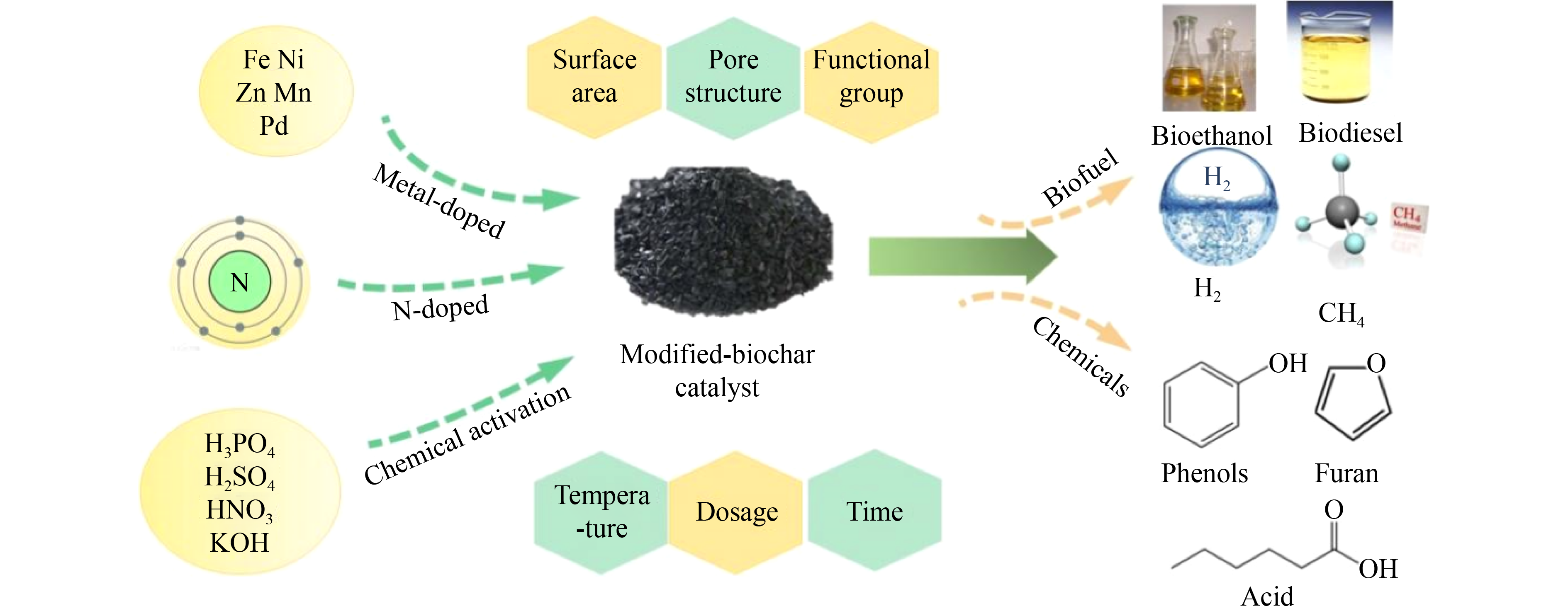Biodiesel, mainly derived from vegetable oils, animal fats, or other materials composed of triacylglycerols, is used as an alternative to traditional petroleum energy [
59,
60]. As one of the most promising renewable and sustainable fuels, biodiesel has the advantages of low- or no content of sulfur, no aromatic content, and biodegradability [
59]. In the process of biodiesel production, catalysts play an extremely important role. Recently, biochar catalysts have been widely and effectively applied in biodiesel production, as they are considered as green and stable catalysts that make a great contribution to advancing the quality of biodiesel. Specifically, sulfonation is viewed as one of the most effective methods to treat biochar, which increases the activity by introducing a covalent bond of sulfonic acid group (SO
2-OH) on the surface of biochar. Quah et al. found that the biochar catalyst obtained by sulfonation with concentrated sulfuric acid could remarkably increase the overall biodiesel selectivity of edible waste oil [
61]. By contrast, the use of 4-benzenediazonium sulfonate (4-BDS) is much milder and the sulfonation process is more stable than the direct use of sulfuric acid. Based on 4-benzene diazonium sulfonate (4-BDS), Lim et al. reported that biochar derived from oil palm empty fruit bunch managed to significantly increase biodiesel selectivity by 98.1% at 200 °C pyrolysis with 15:1 sulfanilic acid [
62]. Generally, a period of 7 h was regarded as the optimum period for transesterification reaction, because the yield of biodiesel increased gradually with the increase of esterification duration, while it had only a slight increment after 7 h. It can be seen that the esterification duration is also a key factor affecting the transesterification reaction. Besides, palm fatty acid distillate (PFAD) was used in biodiesel production, which could fulfill the recycling of the product and the production of high-value biodiesel at the same time. However, the reaction was easily affected by the pyrolysis temperature, and a higher pyrolysis temperature will destroy the catalyst structure, thus affecting the adhesion of the sulfonic acid group [
62,
63]. Moreover, CO
2 is considered to be an effective means to manipulate carbon distributions, which could crack and expand pyrogenic products during pyrolysis, and further react with them [
64]. Yoon et al. found that the use of CO
2 as the reaction medium in the co-pyrolysis of lipid waste and red mud could control the carbon distribution between pyrolysis products, and consequently obtain a biodiesel yield of 92% [
65]. In addition, biodiesel could be produced with a low energy consumption through the catalytic transesterification reaction. Aside from waste fruit shells and peat, the pseudo-catalytic transesterification reaction using biochar that is derived from livestock manure (chicken manure, pig manure) has been investigated. It can be a promising candidate as a catalyst as it realizes energy recovery (biodiesel, pyrolysis oil, H
2 and C1-2HCs). Jung et al. found that the existence of the Ca species in chicken manure could provide alkalinity for transesterification, thus significantly enhancing its catalytic capacity, in which chicken manure biochar at 350 °C exhibited the best performance (95.6%) for biodiesel [
66]. However, biochar that was derived from high content Ca species in chicken manure could impact the catalytic activity and decrease the selectivity for biodiesel by accelerating the thermal cracking. Furthermore, Jung et al. suggested that metal components in pig manure could be an effective catalyst for biodiesel synthesis, resulting in a biodiesel yield of 96% [
67]. Interestingly, biochar that was derived from the pyrolysis of pig manure contained a substantial amount of high value-added gas products (H
2, CO, and CH
4) and pyrolysis oil [
67]. It was also found that pig manure biochar had better reaction kinetics than chicken manure biochar due to the imparted catalytic capability. Therefore, pig manure biochar is believed as an effective and novel means for facilitating reaction kinetics and enhancing the catalytic activity to use of livestock and poultry. Moreover, the algae catalyst with a crystalline structure was modified by Foroutan et al. and was applied for the biodiesel production from edible waste oil [
68]. Among those, a catalyst loading of 4% (mass fraction) was reported as the optimum esterification condition which provided the highest biodiesel yield at 98.83% [
68]. However, prior to the transesterification reaction, high free fatty acid (FFA) was removed from the waste cooking oil to less than 1%, because biodiesel yield was affected by FFA to create some by-products. Furthermore, both biomass reaction temperature and methanol/oil ratio were the key factors that influenced the transesterification reaction. Consequently, both parameters must be well controlled to facilitate the attachment of the biodiesel selectivity. When the reaction temperature was extremely high (over 65 °C), the transesterification reaction experienced methanol evaporates partially and reduced the mass transfer rate between methanol and catalyst [
69]. Additionally, at an extreme excessive methanol/oil ratio, the selectivity for biodiesel of catalyst would also be impacted by the accelerated transesterification reaction which reduced the catalytic activity [
70]. Besides, the production of algal oil derived from cellulosic seaweed has been focused as an effective measure for alternative resources [
71]. Behera et al. showed its excellent catalytic behavior as a heterogeneous catalyst in biodiesel production from algal oil [
43]. In terms of the temperature, catalyst dosage and methanol-oil ratio were the key parameters affecting the transesterification of microalgae oil. When the catalyst dosage was extremely high, it would increase the resistance of mass transfer instead of reducing the production efficiency [
43].










